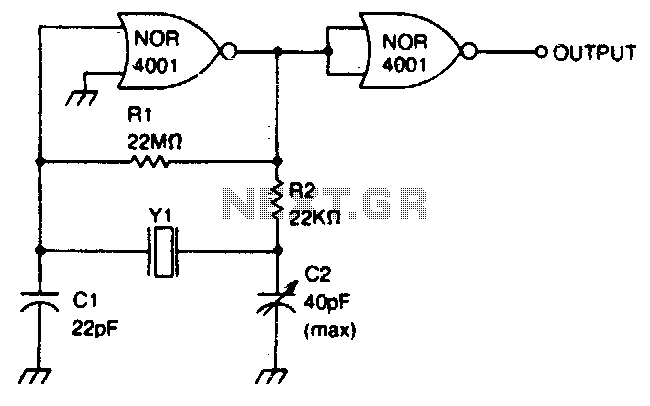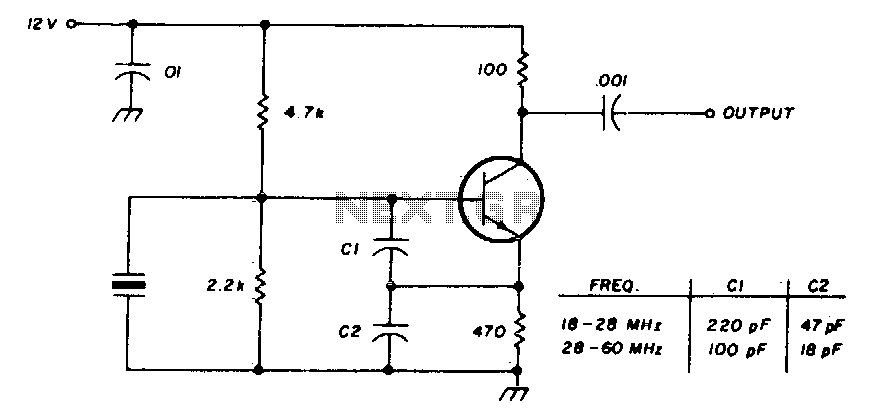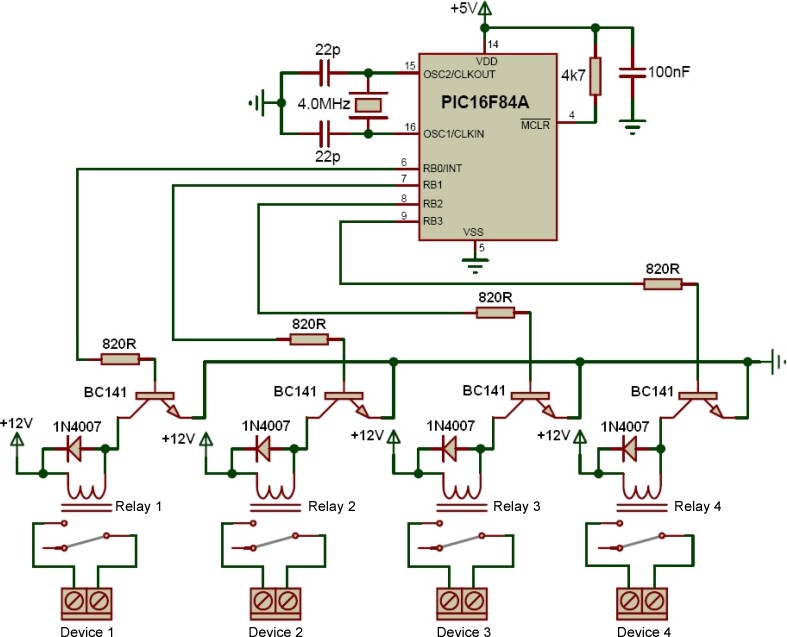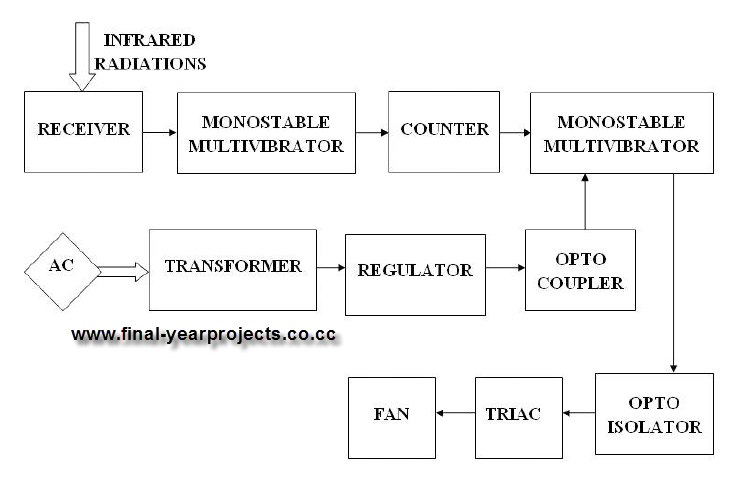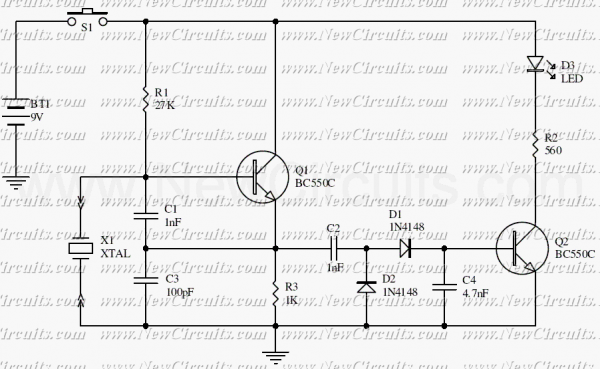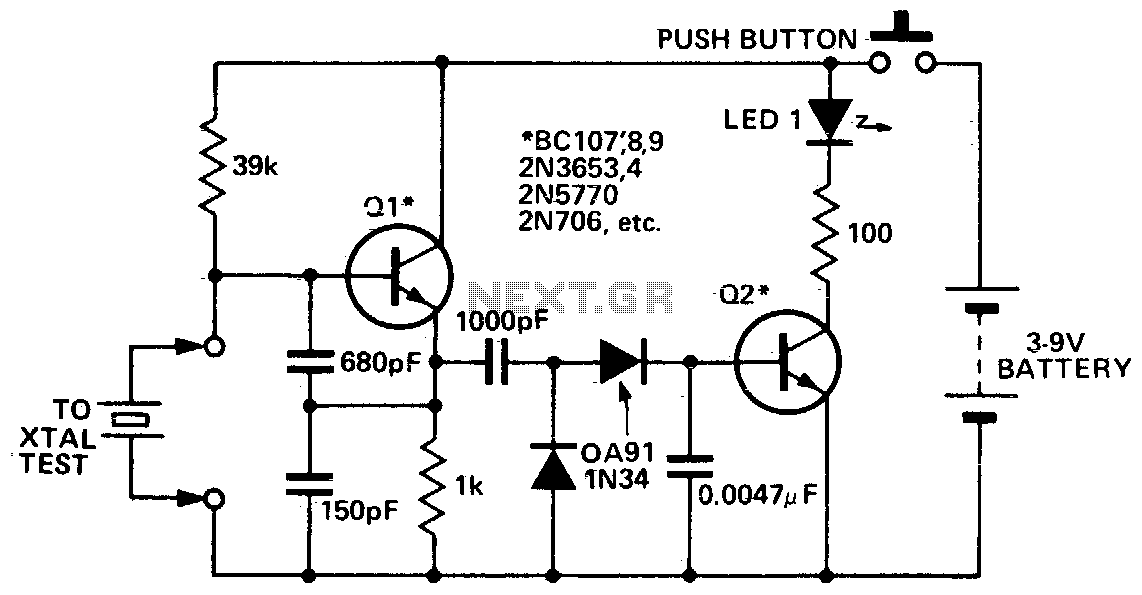
crystal controlled timebase
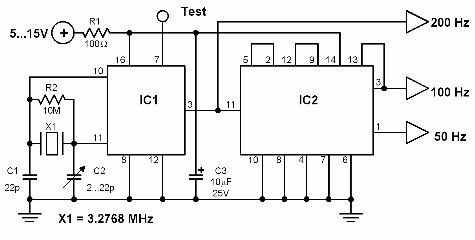
This circuit generates a 50 Hz timebase signal that is independent of the power line frequency. It is designed to provide the 50 Hz signal for electronic circuits that operate specifically with this clock frequency, primarily for circuits and electronic devices adhering to European standards. It is commonly utilized for clock and timing applications. By analyzing the circuit diagram, it can be observed that IC1 operates as a crystal-controlled oscillator, while IC2 functions as a frequency divider. The crystal frequency can be finely adjusted within a 20 Hz range using the trimmer capacitor C2. Calibration can be performed in two different ways. The first method involves connecting a digital frequency counter to pin 7 of IC1 (TEST output on the printed circuit board) and adjusting trimmer capacitor C2 until the displayed frequency is 204.800 Hz.
The circuit operates by utilizing a crystal oscillator to produce a stable frequency, which is then divided down to the desired 50 Hz output. The crystal oscillator, represented by IC1, generates a high-frequency signal that is determined by the characteristics of the crystal used. This high frequency is essential for maintaining accuracy and stability in the timing applications. IC2, serving as a frequency divider, takes the output from IC1 and reduces it to the required 50 Hz frequency by dividing the input frequency by a specific factor.
The trimmer capacitor C2 plays a critical role in fine-tuning the circuit. It allows for minor adjustments to the oscillator frequency, ensuring that the output remains precise. The calibration process is straightforward, enabling users to achieve the desired frequency with minimal effort. By employing a digital frequency counter, the user can accurately monitor the output frequency and make the necessary adjustments to C2.
This circuit finds applications in various electronic devices that require precise timing signals, such as clocks, timers, and other timing-critical systems. Its independence from the power line frequency makes it particularly useful in regions where the power line frequency may vary or in applications where a stable timing reference is essential. Overall, this circuit design provides a reliable solution for generating a 50 Hz timebase signal, ensuring compatibility with European electronic standards and enhancing the performance of timing applications.This circuit provides a 50 Hz timebase signal that is independent from the power line frequency. It is designed to provide the 50 Hz signal for electronic circuits which function only with this clock frequency (mostly circuits and electronic devices with european standards). It is popularly used for clock and timing applications. By carefully anal ysing the circuit diagram, you can see that IC1 works as crystal controlled oscillator while IC2 functions as a 214 divider. The crystal frequency can be finely adjusted within 20 Hz range through the trimmer capacitor C2. Calibration is simple and can be done in two different ways. First method: if you have a digital frequency counter, connect it to pin 7 of IC1 (TEST output on the printed circuit board) and adjust trimmer cap C2 until the frequency being displayed is 204.
800 Hz. 🔗 External reference
The circuit operates by utilizing a crystal oscillator to produce a stable frequency, which is then divided down to the desired 50 Hz output. The crystal oscillator, represented by IC1, generates a high-frequency signal that is determined by the characteristics of the crystal used. This high frequency is essential for maintaining accuracy and stability in the timing applications. IC2, serving as a frequency divider, takes the output from IC1 and reduces it to the required 50 Hz frequency by dividing the input frequency by a specific factor.
The trimmer capacitor C2 plays a critical role in fine-tuning the circuit. It allows for minor adjustments to the oscillator frequency, ensuring that the output remains precise. The calibration process is straightforward, enabling users to achieve the desired frequency with minimal effort. By employing a digital frequency counter, the user can accurately monitor the output frequency and make the necessary adjustments to C2.
This circuit finds applications in various electronic devices that require precise timing signals, such as clocks, timers, and other timing-critical systems. Its independence from the power line frequency makes it particularly useful in regions where the power line frequency may vary or in applications where a stable timing reference is essential. Overall, this circuit design provides a reliable solution for generating a 50 Hz timebase signal, ensuring compatibility with European electronic standards and enhancing the performance of timing applications.This circuit provides a 50 Hz timebase signal that is independent from the power line frequency. It is designed to provide the 50 Hz signal for electronic circuits which function only with this clock frequency (mostly circuits and electronic devices with european standards). It is popularly used for clock and timing applications. By carefully anal ysing the circuit diagram, you can see that IC1 works as crystal controlled oscillator while IC2 functions as a 214 divider. The crystal frequency can be finely adjusted within 20 Hz range through the trimmer capacitor C2. Calibration is simple and can be done in two different ways. First method: if you have a digital frequency counter, connect it to pin 7 of IC1 (TEST output on the printed circuit board) and adjust trimmer cap C2 until the frequency being displayed is 204.
800 Hz. 🔗 External reference
